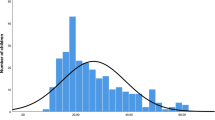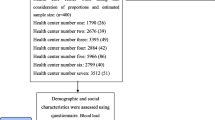Abstract
Blood lead levels (BLLs) of 188 pediatric patients were measured and their parents were queried as to the smoking style in their home. Their mean BLL was 3.16 μg/dl, which was among the lowest levels in the world, and none of them had levels of over 10 μ g/dl. Preschool children ( 1 to 6 years of age) with parents who smoked in the same room had a significantly higher BLL (mean; 4.15 μ g/dl) than those with parents who never smoked (mean; 3.06 μ g/dl) (P<0.01). However, the mean BLL of school children (6 to 15 years of age) with parents who smoked in the same room was not significantly different from that of school children with parents who never smoked. Passive smoking caused an increase of the BLL only in preschool children in Japan. This is probably because preschool infants spend much more time with their parents and have much more contact with passive smoking than school children and, additionally young infants have a limited ability to excrete lead from the body.
Similar content being viewed by others
References
Sargent JD, Brown MJ, Freeman JL, Bailey A, Goodman D, Freeman DH. Childhood lead poisoning in Massachusetts communities: Its association with sociodemographic and housing characteristics. Am J Publ Health 1995;85: 528–34.
Pocock SJ, Smith M, Baghurst P. Environmental lead and children’s intelligence: A systematic review of the epidemiological evidence. Brit Med J 1994;309: 1189–97.
Stromberg U, Schutz A, Skerfving S. Substantial decrease of blood lead in Swedish children, 1978-94, associated with petrol lead. Occup Environ Med 1995;52: 764–9.
Andren P, Schutz A, Vahter M, Attewell R, Johansson L, Willers S, Skerfving S. Environmental exposure to lead and arsenic among children living near a glassworks. Sci Total Environ 1988;77: 25–34.
Willers S, Schutz A, Attewell R, Skerfving S. Relation between lead and cadmium in blood and the involuntary smoking of children. Scand J Work Environ Health 1988;14: 385–9.
Murphy TF, Nomoto S, Sunderman FW. Measurements of blood lead by atomic absorption spectrometry. Annal Clin Lab Sci 1971;1: 57–63.
Miller DT, Paschal DC, Gunter EW, Stroud PE, D’Angelo J. Determination of lead in blood using electrothermal atomisation atomic absorption spectrometry with a L’vov platform and matrix modifier. Analyst 1987;112: 1701–4.
Hayes EB, McElvaine MD, Orbach HG, Fernandez AM, Lyne S, Matte TD. Long-term trends in blood lead levels among children in Chicago: Relationship to air lead levels. Pediatrics 1994;93: 195–200.
Norman EH, Bordley WC, Hertz-Picciotto I, Newton DA. Rural-urban blood lead differences in North Carolina children. Pediatrics 1994;94: 59–64.
Jin A, Hertzman C, Peck SHS, Lockitch G. Blood lead levels in children aged 24 to 36 months in Vancouver. Can Med Assoc J 1995;152: 1077–86.
Sherlock JC, Barltrop D, Evans WH, Quinn MJ, Smart GA, Strehlow C. Blood lead concentrations and lead intake in children of different ethnic origin. Human Toxicol 1985;4: 513–9.
Cambra K, Alonso E. Blood lead levels in 2- to 3-year-old children in the Greater Bilbao Area (Basque Country, Spain): Relation to dust and water lead levels. Arch Environ Health 1995;50: 362–6.
Wietlisbach V, Rickenbach M, Berode M, Guillemin M. Time trend and determinants of blood lead levels in a Swiss population over a transition period (1984-1993) from leaded to unleaded gasoline use. Environ Res 1995;68: 82–90.
Chiba M, Masironi R. Toxic and trace elements in tobacco and tobacco smoke. Bullet WHO 1992;70: 269–75.
Watanabe T, Fujita H, Koizumi A, Chiba K, Miyasaka M, Ikeda M. Baseline level of blood lead concentration among Japanese farmers. Arch Environ Health 1985;40: 170–6.
Japan Tobacco Incorporated. The annual report on smoking rates in Japan (in Japanese). Japan Tobacco Incorporated, Tokyo, 1992.
Hirayama T. Prevention of health hazards in children by active and passive smoking (in Japanese). Pharma Medica 1991;9(11): 57–61.
Kaji M, Gotoh M, Takagi Y, Masuda H. A study on the smoking styles of smokers in the homes of childhood outpatients (in Japanese). Shizuoka J Med 1995;11: 5–9.
Nyhan WL, Sawyer M, Kearney T, Spector S, Hilton S. Lead intoxication in children. West J Med 1985;143: 357–64.
Okada A. A study on the contents of lead in the blood, urine and feces of the healthy Japanese rural population (in Japanese, abstract in English). Osaka City Med J 1957;6: 992–1021.
Author information
Authors and Affiliations
Rights and permissions
About this article
Cite this article
Kaji, M., Gotoh, M., Takagi, Y. et al. Blood lead levels in Japanese children: Effects of passive smoking. Environ Health Prev Med 2, 79–81 (1997). https://doi.org/10.1007/BF02931969
Received:
Accepted:
Issue Date:
DOI: https://doi.org/10.1007/BF02931969




